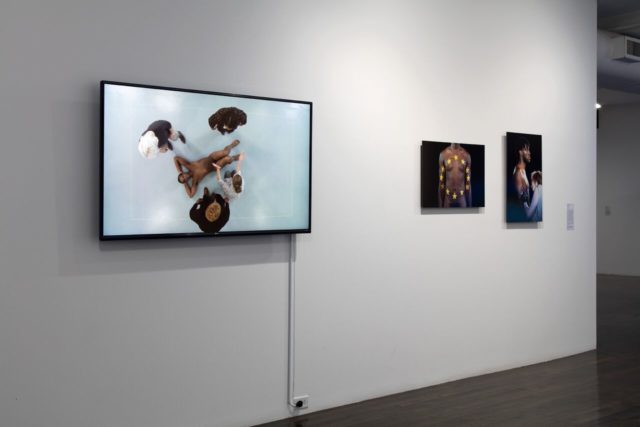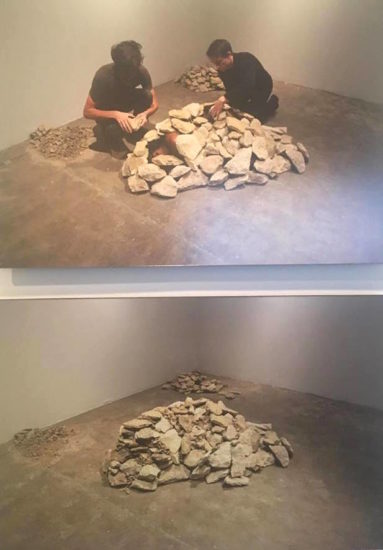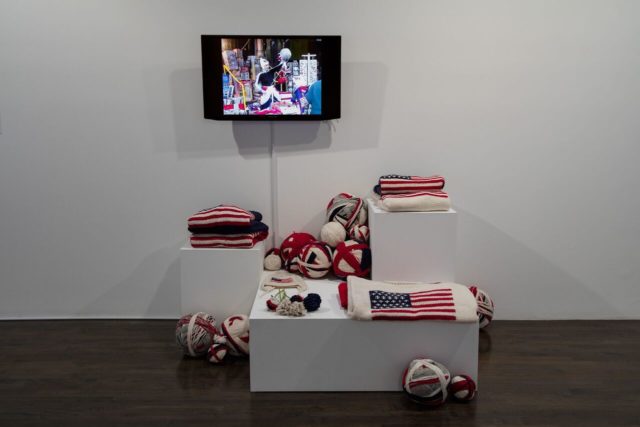
Bruce Nauman, Still from Dance or Exercise on the Perimeter of a Square (Square Dance), 1967-68 (Courtesy Electronic Arts Intermix (EAI), New York)
Enacting Stillness
The 8th Floor
17 West 17th Street, 8th Floor
New York, NY
On view until January 13, 2017
Artists: John Ahearn, Rehan Ansari, Nicolás Dumit Estévez, Brendan Fernandes, Alicia Grullón, Yoko Inoue, Joan Jonas, Claudia Joskowicz, Kirsten Justesen, Kimsooja, Carlos Martiel, Bruce Nauman, Clifford Owens, Kameelah Janan Rasheed, Emily Roysdon, and Roman Štětina
Stillness as a form of protest is nothing new. There are numerous examples of die-ins, sit-ins and even, hunger strikes that mobilize through immobility. And yet, at a time when many are searching for methods of resistance to Trump’s upcoming administration, a reminder of the potential power of stillness seems necessary.
A current exhibition at The 8th Floor provides this much-needed refresher. Enacting Stillness gathers a group of artists who use slow moving bodies and themes of waiting, silence or inaction in order to provoke dialogue and maybe even, political change.
The show, curated by Shelley & Donald Rubin Foundation’s Artistic Director Sara Reisman, traces how contemporary artists built on conceptual experiments in stillness by Bruce Nauman and Joan Jonas to examine more socially relevant issues. The newer works range from Carlos Martiel’s painfully physical performances addressing immigration and xenophobia to Clifford Owens’ similarly endurance-based performances on blackness to Kameelah Janan Rasheed’s prints, which question the slow march of progress through reappropriated quotes by Nina Simone and James Baldwin. The juxtaposition of earlier formalist concerns with current identity politics feels fresh since art on identity is often sequestered into simplistic and potentially ghettoizing exhibitions.
Open since September (after a previous incarnation at Prague’s MeetFactory and a smaller version in 2014 at La MaMa Galleria), the context of the exhibition markedly shifted in November after Trump’s victory. Many of the works in the show, as well as the overall theme of stillness as an activist tool, took on greater significance. Looking ahead to the next four nightmarish years, Enacting Stillness offers stillness as a possible way forward both artistically and politically.
Curious about the timeliness of the exhibition post-election, I spoke with Sara Reisman about her conception of the show, her understanding of stillness as a response to Trump’s election and whether art can influence political change.
What initially inspired the concept of Enacting Stillness?
There’s a book by Andre Lepecki called Exhausting Dance. In the book, Nauman’s Dance or Exercise on the Perimeter of a Square (Square Dance) is used as a case study about the impact of when a performance artist faces away from the viewer. It raises questions like, “What am I doing here as the viewer?” There is a political potential operating in a performance that’s not pandering to the viewer. Square Dance anchors the show. Now, I don’t know what the politics are in this [Square Dance], but I don’t read it politically. I read it more formally. For this reason, it may not be the best case study for the show, but nonetheless, it exists as a symbolic reference to an inspiration behind the show’s beginnings.

Installation view of Enacting Stillness at The 8th Floor (Courtesy the artists and The 8th Floor, New York)
That brings up one of the aspects I found refreshing about the exhibition. You combine works that have a formal interest in stillness, like the Nauman piece, with more politically driven pieces. Art dealing with identity politics is often separated into its own shows. What interested you about this combination?
It’s something I’m interested in doing in general as a curator because I think there is or there has been a stigma attached to identity-based work. Although, we’re in a time when that has to go away. Even in the last five years, I’ve heard people refer to art that considers race or ethnicity as “so 90’s.” Even in the last five years, it was seen as “so 90’s” to think of art in terms of race or ethnicity.
You also mentioned the role of the viewer. How does art employing stillness uniquely engage with its audience?
I think when performance art is brought into the gallery, there’s this tension around the endurance of the viewer. A lot of the work requires a kind of patience in order to understand what is imbedded in the work. For example, Claudia Joskowicz’s Sympathy For The Devil short two channel video (8 min)connects two neighbors in Bolivia–one who escaped the Holocaust in Poland and Klaus Barbie [a Nazi living under an assumed name] who is his upstairs neighbor. Claudia was interested in the collision of these two figures that happens on a daily basis. One of the things she does with the film is a tracking shot that connects the different narrative points very slowly. There’s space to find out what the video means if someone is willing to put in the work, read the label and give the video their time. This relationship with the viewer gives space for a more charged analysis or reaction.
In your catalogue essay, you write on stillness: “Between slowness and stopping all together is a temporal space of possibility: being still.” How do you define stillness?
I worked at the Lower Manhattan Cultural Council through the 9/11 era. The last performance done at the World Trade Center Plaza before September 11th was a series called “Evening Stars,” commissioned by Port Authority. The final performer was Twyla Tharp on September 9, 2001. She talked about how it made sense to be doing a performance at the bottom of these buildings, which you think are still, but are actually moving in order to be structurally sound. Of course, two days later, they came down. That changes how you think about everything. No object or body is really still. The connection that emerged for me was the relationship between the way stillness is conceived and the way it is designed in performance art and activism.

Carlos Martiel, Ruins, 2015, C-prints on PVC (photo by author)
Speaking of activism, Enacting Stillness opened before Trump’s election win, but many of the works are chillingly relevant now. Take Carlos Martiel’s performance Ruins, in which assistants buried his curled up body in a pile of rocks as a representation of the physical oppression immigrant bodies and the building of walls. Did the tone of the show shift post-election? How?
At a later point in planning the show, there was some thought like, “Oh, the election will happen. That will make some of the conversations we plan to have more political and more poignant.” But, I didn’t know which way it would go. I assumed Hillary Clinton would win–a candidate with experience, a background in politics and more integrity.
What was interesting though is I actually had some anxiety around the idea of stillness as a real response to politics. Personally, I don’t think being still or hanging back is acceptable. people need time to respond and that response time can appear to be passive. But, thought is not a passive, still activity. It just doesn’t show. One needs that time. So I’d advocate for something like stillness to do that. In the long term, though, it isn’t a feasible or responsible way to react.
When thinking of stillness in terms of activism, I immediately thought of sit-ins and other forms of nonviolent protest.
A strike or a sit-in communicates a political response that’s understood. We had a conversation a few weeks ago with Kameelah Janan Rasheed. She was talking in connection with the election–and I keep hearing it in certain circles–that nothing’s changed. What’s changed is that we’re now aware of how more people feel. People of color have been in a corner saying, “This is what’s happening” for so long. Her contributions in the show include quotes from different writers–Nina Simone, Martin Luther King Jr. and James Baldwin. In Baldwin’s piece, there’s the line, “How much time do you want for your progress?” Kameelah talked about waiting for progress. There’s a cyclical dynamic around waiting. Being told you have to wait your turn and wait for things to change and being too late. What that wait represents is a lack of infrastructure, support and equity.

Installation view of Yoko Inoue’s Transmigration of the SOLD in Enacting Stillness at The 8th Floor (Courtesy the artist and The 8th Floor, New York)
Most of the work in the show addresses politics on some level. Do you think art has the capacity to motivate change?
I have an answer that isn’t just about this show. We did an exhibition last year that opened in November called When Artists Speak Truth. It was meant to highlight the role of artists in terms of communicating politics that can’t otherwise be stated by those in official positions of power. There are ways artists can communicate something that may not seem as threatening because it’s coming from an artist. But, it still infiltrates.
I also recently wrote a short piece about social justice in art. If you look back to the Occupy movement, it wasn’t an artwork. But, the projections on the former Verizon building at the November 17th event after the clearing of Zuccotti Park were by artists. The messaging of politics is often done best by artists.
Art has an impact. Maybe some of the thinking happens in its own bubble but, I don’t think it’s completely separate from the context of everything else in America. I think the messages in art can be deployed in different ways.


Comments on this entry are closed.